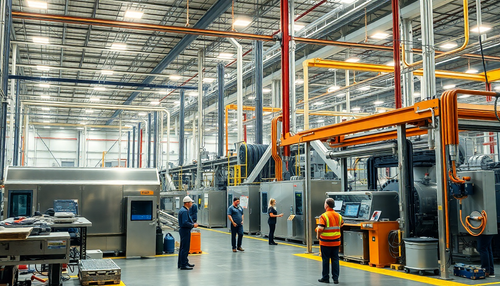
The "Nem-Nem" youth crisis in Brazil: Challenges and future projections
The increase in the number of young people who do not work, study or look for a job, the so-called "nem-nem", is a growing phenomenon in Brazil and raises concerns in different spheres of society. Recently, the Undersecretariat of Labor Statistics and Studies, of the Ministry of Labor and Employment, released alarming data on this issue during the Youth Employability event, promoted by the Business-School Integration Center (CIEE) in São Paulo.
The number of "neither-neither" young people grew significantly, rising from 4 million to 5.4 million between the first quarter of last year and the same period this year.
The factors behind the rise of young "neithers"
Why is the number of “neither” youth increasing?
This increase can be attributed to a number of factors, with a disproportionate impact on young women, who make up 60% of this group. Paula Montagner, Undersecretary of Statistics and Studies at the Ministry of Labor and Employment, highlights that the difficulty of young women in entering the job market is a crucial factor. Furthermore, social conservatism and the call for young women to have children earlier contribute to them entering the job market later and with less qualifications, making it difficult to obtain well-paid jobs.
- Late insertion and lack of professional qualifications make young women more vulnerable to unemployment and underemployment.
- Social pressure for young women to have children early can delay or interrupt their professional careers.
The Nest Egg Program: A potential solution?
To face the challenge of school dropout among low-income young people, the federal government launched the Pé-de-Meia program, which offers financial incentives for these young people to remain enrolled and complete high school. The program provides for the payment of up to R$9,200 over the three years of high school, in addition to an additional amount for those who participate in the National High School Exam (Enem).
How can the Pé-de-Meia program impact young people?
Although promising, Paula Montagner notes that the effects of this program will only be felt in the coming years. If successful, it could significantly reduce the number of young people dropping out of school, improving their chances of entering the job market with better qualifications.
- The financial incentive aims to reduce school dropout among low-income young people.
- The program's impact on reducing "neither-neither" youth will be assessed in the long term.
The reality of youth occupation and unemployment
Around 17% of the Brazilian population is made up of young people between 14 and 24 years old, totaling 34 million people. Of these, 14 million were employed in the first quarter of this year, but 45% of them worked informally, which corresponds to 6.3 million individuals. This rate is higher than the national average of informality, which is 40%.
What are the consequences of high informality among young people?
The high rate of informality among young people can be attributed to the fact that many work in micro and small companies without formal contracts. This prevents them from accessing employment benefits and reduces their long-term career prospects.
- Informality deprives young people of labor benefits and job security.
- Informal jobs make it difficult to develop a stable and well-paid career.
Growth of apprentices and interns: A light at the end of the tunnel?
There has been significant growth in the number of apprentices and interns in Brazil in recent years. Between 2022 and 2024, the number of apprentices increased by 100 thousand, reaching 602 thousand in April this year. The number of interns grew by 37%, from 642 thousand to 877 thousand.
How can an increase in apprentices and interns benefit young people?
Rodrigo Dib, from CIEE's institutional superintendency, highlights the importance of including young people in the world of work in a safe way, highlighting that youth employability is an urgent challenge for Brazil. Apprenticeship and internship programs provide young people with opportunities to gain practical experience and develop skills that are crucial for their future careers.
- The growth of apprenticeship and internship programs is positive, but there is still much to be done.
- The practical experience obtained through these programs is essential for the productive insertion of young people in the job market.
Challenges and future perspectives
Paula Montagner emphasizes the need to increase young people's education to improve their chances in the job market. Furthermore, she highlights the importance of internships and learning programs connected to technical and vocational education. This approach not only helps young people get jobs, but also develop a solid career.
What can be done to improve the employability of young people in Brazil?
The solution involves a combination of effective public policies, educational incentives and professional qualification programs. It is essential to create an environment that facilitates young people's transition from school to the workforce, ensuring they have the skills and experience they need to thrive.
- Increasing the education and technical qualifications of young people is essential.
- Internships and learning programs must be aligned with the needs of the job market.
The increase in young people who do not work or study is an alarming reflection of systemic failures in Brazil. These young people, often unmotivated and without clear prospects, face a job market that does not offer sufficient opportunities and an educational system that fails to adequately prepare them for the future. The lack of effective inclusion and support policies perpetuates a cycle of dependence and low qualifications, which only tends to worsen over time.
The government's initiative with the Pé-de-Meia program, although well-intentioned, appears to be a palliative solution that does not address the root causes of the problem. Financial incentives may help temporarily, but they do not replace the need for structural reforms in education and the labor market. It is essential that conditions are created so that these young people not only remain in school, but also acquire relevant skills and have access to formal, well-paid jobs.
The informality that dominates youth employment is another symptom of the precariousness that characterizes the trajectory of these young people. Without formal employment opportunities, many are forced to accept informal work, perpetuating a cycle of instability and low income. It is crucial that public policies are developed to effectively integrate these young people into the job market, offering not only financial incentives, but also quality education and real employment opportunities.
Concluding
The increase in the number of “neither-nor” young people in Brazil is a complex challenge that requires a multifaceted approach. Policies such as the Pé-de-Meia program and the growth of apprenticeship and internship programs are steps in the right direction, but there is still much to be done to improve the employability of young people. The key to success lies in the combination of education, professional qualifications and practical work opportunities.
Your opinion is important! Leave your comments below about the strategies to face the challenge of “neither-nor” young people and your expectations for the future of Brazilian youth.


















































